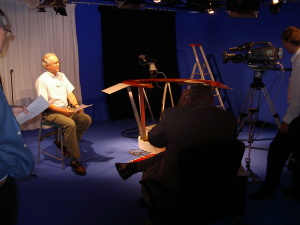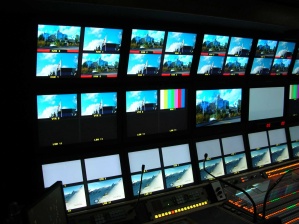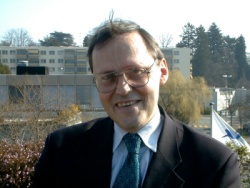Rec. ITU-R BT.601 25th Anniversary and still Žin forceŽ - the bridge that joined the analogue and digital worlds (1982-2007)
|
Recommendation ITU-R BT.601 - the milestone of DTV worldwide, celebrates 25 years on 17 February 2007.

See Article ITUNEWS 2000/02
|
"Hundreds of millions of digital television receivers in use 24/7 throughout the world are based on it. DVDs use it. Rec. 601 is, and will continue to be, also the building block of higher quality television systems"
says David Wood, Head of New Technology, EBU, Geneva (see article below).
Recommendation ITU-R BT.601 became a part of history as a common world standard for digital television studios. In 1983 the CCIR, at the time under the directorship of Mr. Richard Kirby, received from the United States of America, "The National Academy of Television Arts and Sciences" Award for the development of this standard.
THE NATIONAL ACADEMY OF TELEVISION ARTS AND SCIENCES
1982 - 1983 TELEVISION ACADEMY AWARDS
Outstanding Achievement in Engineering Development
TO THE INTERNATIONAL RADIO CONSULTATIVE COMMITTEE OF THE I.T.U. (CCIR)
"For providing the international forum to achieve a compromise of national committee positions
on a digital video studio standard and to achieve agreement within the 1978-82 study period." |
ABOUT THE NATAS AWARD
Launched in 1948, Technology and Engineering
Awards honor development and innovation in broadcast technology and
recognize companies, organizations and individuals for breakthroughs in
technology that have a significant effect on television engineering. An award to
an individual, a company, or to a scientific or technical organization for
developments and/or standardization involved in engineering technologies which
either represent so extensive an improvement on existing methods or are so
innovative in nature that they materially have affected the transmission,
recording, or reception of television. |
|
Rec. ITU-R BT.601 - the bridge that joined the analogue and digital worlds
by David Wood, Head of New Technology, EBU, Geneva
Former Chair of CCIR1 IWP 11/4, ITU-R Working Party 11A
|
An ITU meeting can change the world. An ITU document, 11/1027, describing the parameter values for a digital video format was approved by CCIR Study Group 11 in autumn 1981. In February 1982, 25 years ago, the CCIR Plenary Assembly approved this as Draft Rec. AA/11 "Encoding Parameters for Digital Television for Studios", which became "ITU-R Rec. 601".
Rec. 601 became the most quoted, most used, technical document in the history of the media. It is the basis for all television today, including not only conventional quality video, but also higher quality forms 720p, 1080i, and 1080p. Its application will stretch far into the future. The author had the privilege of chairing the drafting group that prepared it, and helping the international negotiations that led to it.
The success was due to the enormous amount of work done before the CCIR meeting itself, and the remarkable Chair of CCIR Study Group 11, Prof. Mark Krivocheev. It also had that vital ingredient - it was 'an idea whose time had come'.
|
 |
At the time, broadcasting was on the verge of the great transition from the analogue to the digital world. Digital television equipment was already beginning to appear. But these were all digital versions of the different analogue televisions in use across the world - PAL, SECAM, and NTSC. Could we 'seize the day' and agree a common digital system? Was the world ready to compromise this time?
The challenge was to find a system which would be usable with, but not favour, any of the existing analogue systems. A 'win-win' system was needed. Two breakthrough ideas allowed this - the use of 'component coding', and the choice of a luminance sampling frequency which was a common multiple of the line frequencies of all the analogue systems.
|
|
The originator of the parameters of this system was the author's friend and colleague, Stanley Baron from NBC. He proposed a new system that would have two field rate options with a common sampling pattern per active line, which was "orthogonal" ("stationary" from line to line and field to field).
|
|
The agreement at the CCIR meetings had been trail-blazed by an enormous amount of work. There were laboratory tests in many parts of the world - Europe, the US, Japan - to substantiate the parameter values proposed. There was much world travel, by the author and others, to explain at length what the choices were, and why the proposed values were the best compromise. This was victory aided by planning and preparation before the meeting.
So many people were involved it is impossible to name them all - but they know who they are and what they did. Risking their anger by mentioning just a few, the author recalls the Richard Green who led the US team with his heart. Mr Tadokoro from Japan who achieved a laboratory analysis in an incredibly short time, to allow Japan to agree. And what would we have done without the late Howard Jones and Jacques Sabatier from Europe? The success, as always, was also only possible because of the work of the permanent staff of the ITU - the unsung Heros.
|
 |
Rec. 601 was the specification for the 'mathematical description' of the digital television signal for conventional quality television. Digital recording and interface formats were developed based on it. Hundreds of millions of digital television receivers in use 24/7 throughout the world are based on it. DVDs use it. Rec. 601 is, and will continue to be, also the building block of higher quality television systems.
Rec. 601 was the right thing, at the right time, done in the right way.
Rec. ITU-R BT.601 - Studio encoding parameters of digital television for standard 4:3 and wide screen 16:9 aspect ratios.

David Wood, Head of New Technology, EBU, Geneva
Former Chair of CCIR1 IWP 11/4, ITU-R Working Party 11A
1 The CCIR was the predecessor of the ITU-R.
|
|
|
|
|





